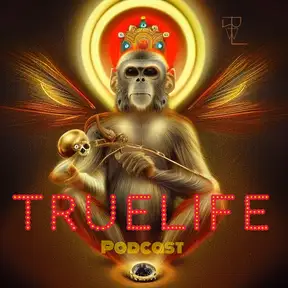Dr. David Salomon - The Codex Chronicles| Saint Inatius of Loyola
One on One Video Call W/George
https://tidycal.com/georgepmonty/60-minute-meeting
Support the show:
https://www.paypal.me/Truelifepodcast?locale.x=en_US
🚨🚨Curious about the future of psychedelics? Imagine if Alan Watts started a secret society with Ram Dass and Hunter S. Thompson… now open the door.
Use Promocode TRUELIFE for Get 25% off monthly or 30% off the annual plan For the first year
Welcome to The Codex Chronicles… A professor’s Tale of Manuscripts.
https://davidsalomonblog.wordpress.com
https://cnu.edu/people/davidsalomon/
Dr. David A. Salomon holds a PhD in English literature from the University of Connecticut and an MA from the City University of New York. A specialist in the literature, religion and culture of the Middle Ages and Renaissance England, he most recently spent thirteen years as a professor of English at the Sage Colleges in Troy and Albany, NY. During his time there, he also served as chair of the Department of English and Modern Languages, director of general education, director of study abroad, chair of the Faculty Development Committee, faculty advisor for the student newspaper, and was the founding director of the Kathleen Donnelly Center for Undergraduate Research. He joined CNU as the inaugural Director of Undergraduate Research and Creative Activity in September 2017.
His book on the medieval glossed Bible was published by the University of Wales Press in 2013. In 2015, he co-edited and co-authored a monograph, Redefining the Paradigm, which discussed new models for faculty evaluation to improve student learning. His new book, The Seven Deadly Sins: How Sin Influenced the West from the Middle Ages to the Modern Era, was published by Praeger in April 2019. He has published essays on everything from medieval mysticism to anger in the Bible, and has given presentations on teaching and faculty evaluation models at conferences, such as the Teaching Professor and the annual AACU Conference.
Medieval manuscripts are perceived differently by the human senses compared to common text today, offering a unique and multisensory experience:
1. Visual Aesthetics: Medieval manuscripts, often handwritten and lavishly decorated, showcase intricate calligraphy, elaborate illustrations, and vibrant colors. The visual aesthetics of these manuscripts evoke a sense of artistry and craftsmanship that is distinct from modern printed text.
2. Tactile Sensation: The parchment or vellum used for medieval manuscripts provides a tactile experience as one feels the texture of the material beneath their fingers. This physical interaction with the medium adds a sensory dimension to reading and handling these historical texts.
3. Aged Scent: Over time, medieval manuscripts develop a distinct aroma, carrying the scent of antiquity. This aged smell can evoke a feeling of connection to the past and contribute to the overall sensory experience.
4. Historical Connection: Reading medieval manuscripts allows individuals to connect with the past in a way that digital or modern printed texts cannot replicate. The physicality of holding an ancient document establishes a direct link to the historical era in which it was created.
5. Auditory Silence: Unlike the electronic devices that accompany much of modern reading, medieval manuscripts invite a quieter environment for exploration. The absence of electronic buzz allows readers to immerse themselves in the silence of the written word.
6. Cultural Imagination: The experience of reading medieval manuscripts transports readers into a different cultural mindset, understanding the context in which these texts were written, interpreted, and appreciated.
7. Spiritual and Mystical Essence: For manuscripts related to religion and mysticism, the act of reading becomes a spiritual journey, as the physicality of the text and the esoteric content converge to create a unique spiritual experience.
In summary, medieval manuscripts offer a multisensory encounter that goes beyond the mere act of reading. The visual aesthetics, tactile sensation, historical connection, and spiritual essence create a captivating journey that connects readers to both the words on the page and the distant world from which they emerged.
https://davidsalomonblog.wordpress.com
https://cnu.edu/people/davidsalomon/
Dr. David A. Salomon holds a PhD in English literature from the University of Connecticut and an MA from the City University of New York. A specialist in the literature, religion and culture of the Middle Ages and Renaissance England, he most recently spent thirteen years as a professor of English at the Sage Colleges in Troy and Albany, NY. During his time there, he also served as chair of the Department of English and Modern Languages, director of general education, director of study abroad, chair of the Faculty Development Committee, faculty advisor for the student newspaper, and was the founding director of the Kathleen Donnelly Center for Undergraduate Research. He joined CNU as the inaugural Director of Undergraduate Research and Creative Activity in September 2017.
His book on the medieval glossed Bible was published by the University of Wales Press in 2013. In 2015, he co-edited and co-authored a monograph, Redefining the Paradigm, which discussed new models for faculty evaluation to improve student learning. His new book, The Seven Deadly Sins: How Sin Influenced the West from the Middle Ages to the Modern Era, was published by Praeger in April 2019. He has published essays on everything from medieval mysticism to anger in the Bible, and has given presentations on teaching and faculty evaluation models at conferences, such as the Teaching Professor and the annual AACU Conference.
Medieval manuscripts are perceived differently by the human senses compared to common text today, offering a unique and multisensory experience:
1. Visual Aesthetics: Medieval manuscripts, often handwritten and lavishly decorated, showcase intricate calligraphy, elaborate illustrations, and vibrant colors. The visual aesthetics of these manuscripts evoke a sense of artistry and craftsmanship that is distinct from modern printed text.
2. Tactile Sensation: The parchment or vellum used for medieval manuscripts provides a tactile experience as one feels the texture of the material beneath their fingers. This physical interaction with the medium adds a sensory dimension to reading and handling these historical texts.
3. Aged Scent: Over time, medieval manuscripts develop a distinct aroma, carrying the scent of antiquity. This aged smell can evoke a feeling of connection to the past and contribute to the overall sensory experience.
4. Historical Connection: Reading medieval manuscripts allows individuals to connect with the past in a way that digital or modern printed texts cannot replicate. The physicality of holding an ancient document establishes a direct link to the historical era in which it was created.
5. Auditory Silence: Unlike the electronic devices that accompany much of modern reading, medieval manuscripts invite a quieter environment for exploration. The absence of electronic buzz allows readers to immerse themselves in the silence of the written word.
6. Cultural Imagination: The experience of reading medieval manuscripts transports readers into a different cultural mindset, understanding the context in which these texts were written, interpreted, and appreciated.
7. Spiritual and Mystical Essence: For manuscripts related to religion and mysticism, the act of reading becomes a spiritual journey, as the physicality of the text and the esoteric content converge to create a unique spiritual experience.
In summary, medieval manuscripts offer a multisensory encounter that goes beyond the mere act of reading. The visual aesthetics, tactile sensation, historical connection, and spiritual essence create a captivating journey that connects readers to both the words on the page and the distant world from which they emerged.
One on One Video call W/George
https://tidycal.com/georgepmonty/60-minute-meeting
Support the show:
https://www.paypal.me/Truelifepodcast?locale.x=en_US
Check out our YouTube:
https://youtube.com/playlist?list=PLPzfOaFtA1hF8UhnuvOQnTgKcIYPI9Ni9&si=Jgg9ATGwzhzdmjkg
https://tidycal.com/georgepmonty/60-minute-meeting
Support the show:
https://www.paypal.me/Truelifepodcast?locale.x=en_US
Check out our YouTube:
https://youtube.com/playlist?list=PLPzfOaFtA1hF8UhnuvOQnTgKcIYPI9Ni9&si=Jgg9ATGwzhzdmjkg
Creators and Guests

Host
George Monty
My name is George Monty. I am the Owner of TrueLife (Podcast/media/ Channel) I’ve spent the last three in years building from the ground up an independent social media brandy that includes communications, content creation, community engagement, online classes in NLP, Graphic Design, Video Editing, and Content creation. I feel so blessed to have reached the following milestones, over 81K hours of watch time, 5 million views, 8K subscribers, & over 60K downloads on the podcast!

